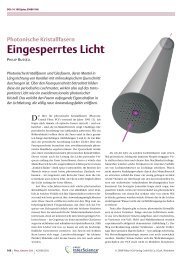Diploma thesis
Diploma thesis
Diploma thesis
Create successful ePaper yourself
Turn your PDF publications into a flip-book with our unique Google optimized e-Paper software.
that the phasematching point was shifted out of the detection range. As an additional<br />
remark the scaling is not comparable to the first measurements. Differences in<br />
the incoupling into the spectrometers render any quantitative comparison between<br />
the different measurement series impossible. For the full data set please refer to<br />
Shg power Pump power [a.u.]<br />
8<br />
7<br />
6<br />
5<br />
4<br />
3<br />
2<br />
1<br />
Shg spectrum<br />
Pump spectrum<br />
Mapping pump wavelength to shg wavelength<br />
0<br />
700 720 740 760 780 800 820 840<br />
Shg wavelength [nm] Pump wavelength [nm/2]<br />
Figure 4.19: No phasematching<br />
Shg power Pump power [a.u.]<br />
8<br />
7<br />
6<br />
5<br />
4<br />
3<br />
2<br />
1<br />
Shg spectrum<br />
Pump spectrum<br />
Mapping pump wavelength to shg wavelength<br />
0<br />
700 720 740 760 780 800 820 840<br />
Shg wavelength [nm] Pump wavelength [nm/2]<br />
Figure 4.20: New peak<br />
appendix A.4.2.<br />
To authenticate these measurements, we scanned another waveguide in the crystal,<br />
from 1520 to 1660 nm pump wavelength (Figures 4.21 to 4.24). The data is in full<br />
accordance with our first experiment. The spectral distributions are clearly amplified<br />
towards the phasematching point at 780 nm, where a huge gain increase occurs (full<br />
data in Appendix A.4.2).<br />
Taking everything into account, we identified one phasematching point for crystal<br />
BCT0703-B12 at 780 nm. At this point the chip fulfills the phasematching condition<br />
and therefore it exhibits ∆k = 0.<br />
How does the theory match with this data? To account for errors, we introduce a<br />
new kE-vector into our phasematching function. This error or fitting vector is used<br />
to fit the predictions of the theory to the experimental data.<br />
∆k = kSHG − kp1 − kp2 − kΛ − kE<br />
(4.10)<br />
For crystal BCT0703-B12, with a poling period of 92 µm we get a kE-vector of<br />
-0.02410 / µm (see Table 4.2).<br />
kSHG 14.1787 / µm<br />
kp1 6.97257 / µm<br />
kp2 7.29812 / µm<br />
kΛ 0.06786 / µm<br />
-0.02410 / µm<br />
kE<br />
Table 4.2: Calculated k-vectors of the observed degenerate SHG process<br />
51



